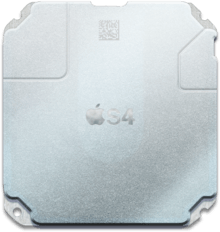Apple S4
The Apple S4 is the integrated computer in the Apple Watch Series 4 and is a custom-designed "System in Package" (SiP) by Apple Inc.[1]
 | |
| General Info | |
|---|---|
| Launched | September 2018 |
| Discontinued | September 2019 |
| Designed by | Apple Inc. |
| Architecture and classification | |
| Application | Apple Watch Series 4 |
| Microarchitecture | Tempest |
| Instruction set | ARM AArch64 – ARMv8.3-A |
| Physical specifications | |
| Cores |
|
| History | |
| Predecessor | Apple S3 |
| Successor | Apple S5 |
The S4 introduced 64-bit ARMv8 cores to the Apple Watch. The chip contains two Tempest cores[2][3], which are the energy-efficient cores from the A12. Despite the small size, Tempest still uses a 3-wide decode out-of-order superscalar design, which make them much more powerful than previous in-order cores.
The S4 contains a Neural Engine that is able to run Core ML.[4] Third-party apps can use it starting from watchOS 6.
The SiP includes new accelerometer and gyroscope functionality that has twice the dynamic range in measurable values of its predecessor, as well as being able to sample data at 8 times the speed.[5] It also contains a new custom GPU, which can use the Metal API.[6]
The S4 was succeeded by the Apple S5, a variant with built-in magnetometer.
See also
- Apple Silicon, the range of ARM-based processors designed by Apple
References
- "Apple Watch Series 4 Teardown". iFixit (in Dutch). 2018-09-24. Retrieved 2019-09-18.
- "Apple Watch S4 SoC Process Node".
- "Yeah. The S4 Apple watch SoC is actually using Two Tempest (LITTLE) cores. Pret... | Hacker News". news.ycombinator.com. Retrieved 2019-09-18.
- "watchOS - Apple Developer". developer.apple.com. Retrieved 2019-09-18.
- Frumusanu, Andrei. "Apple Announces The Apple Watch 4: Fully Custom SiP". www.anandtech.com. Retrieved 2019-09-18.
- Troughton-Smith, Steve (2018-10-02). "Ok we may not have an Apple Watch benchmark, but holy shit I can do 60fps physically-based Metal rendering and realtime physics on the Series 4 pic.twitter.com/GXza08pgIP". @stroughtonsmith. Retrieved 2019-09-18.
